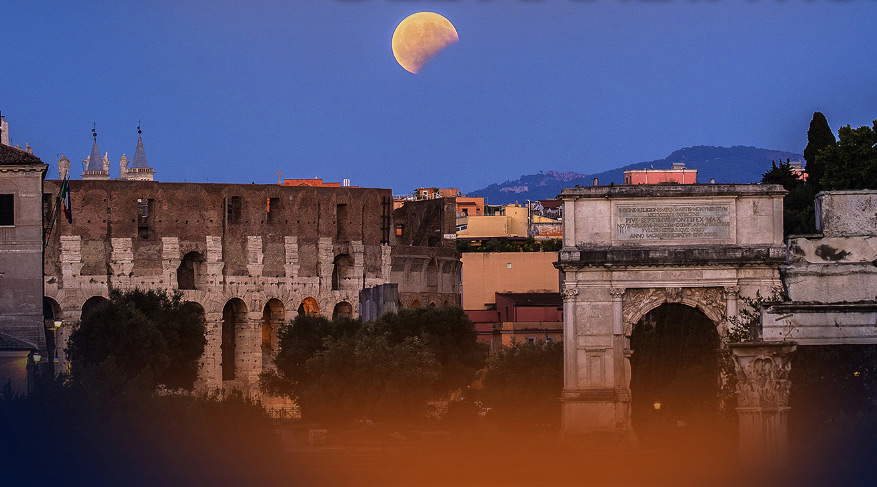Tonight, July 27, 2018, there will be the longest total lunar eclipse of the 21st century: it will begin around 7 p.m., and astronomers calculate that the so-called totality phase (i.e., the time when the moon will be maximally obscured) will last one hour and three quarters, while the entire event, from the beginning to the return of full visibility of the moon’s disk brightness, will last about four hours. The totality phase is expected between 9:30 p.m. and 11:13 p.m.: the right time to enjoy a spectacle, and as a result many Italian museums have come up with many ad hoc initiatives to observe the spectacle in the sky.
In Rome, at the Colosseum, we celebrate the Night of the Red Moon and the Red Planet: an extraordinary opening of the Archaeological Park with an evening, from 9 p.m. to midnight, of public observation from a wonderful place, namely the Temple of Venus and Rome, a few steps from the Colosseum and the Arch of Constantine. The event will be open free of charge.
At Ostia Antica, in the Castle of Julius II, there will be the BloodMoon event: expert astronomers will explain the eclipse and guide participants in observing and recognizing constellations and planets. The appointment is from 9 p.m. but the initiative is limited in number and reservations must be made by sending an email to ostianticaviva@gmail.com.
In Perugia, at the Villa del Cardinale, from 8 p.m. a special dinner to observe the lunar eclipse.
In Caprera, at the Garibaldi National Memorial Museum, there will be an extraordinary evening to allow visitors to observe the event: the elevated position enjoyed by Fort Arbuticci, the distance from the town and from artificial illuminations, make the space one of the most suitable and suggestive places for observing the sky.
In Santa Maria Capua Vetere there will be an extraordinary opening of the Campanian Amphitheater with an evening with the Leopardian title: Che fai tu, luna in ciel? The Longest Eclipse of the Century: the event will be enjoyed with a meeting curated by Massimo Capaccioli, professor emeritus of Astrophysics, University of Naples Federico II, and with musical accompaniment by pianist Fabio Tommasone and words by actor Luigi Cinone.
At Castel del Monte there will be the International Moon Eclipse Evening: an astronomical observatory with telescopes and binoculars will be set up on the castle esplanade, thanks to which the public will be able to follow the event. There will also be a meeting with talks by Patrizia Caraveo, an astrophysicist from the Institute of Space Astrophysics and Cosmic Physics in Milan, and Giacinto Gianfiglio, head of engineering systems for the Exomars mission.
But there are many other Italian museums where the eclipse will be observed. For example, in Viterbo, where the Palace of the Popes will provide the public with a professional telescope; in Padua, where the Tower of La Specola Museum will be open to observe the eclipse both with the naked eye and by means of telescopes; and again in Brescia, at the Specola del Castello, with equipment provided by the Museum of Natural Sciences; in Lastra a Signa (Florence), with astrophiles Mauro Bertini and Luca Franchini who will illustrate the eclipse to the public at the Enrico Caruso Museum (which will be free to visit for the occasion), in the panoramic terrace, in Naples, with the event The moon in the castle organized on the parade ground of Castel Sant’Elmo (open free of charge).
 |
| Many initiatives in Italian museums for the great lunar eclipse, the longest of the century |
Warning: the translation into English of the original Italian article was created using automatic tools. We undertake to review all articles, but we do not guarantee the total absence of inaccuracies in the translation due to the program. You can find the original by clicking on the ITA button. If you find any mistake,please contact us.